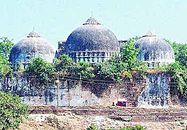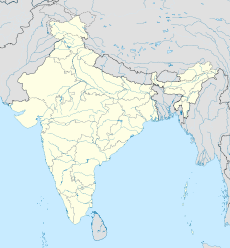- Demolition of Babri Masjid
-
Demolition of Babri Masjid Date December 6, 1992 Attack type Riot Perpetrator(s) Karsevaks The Demolition of Babri Masjid was the destruction of the 16th-century mosque of Babri Masjid in Ayodhya, Uttar Pradesh, India, on December 6, 1992 by Hindu Karsevaks in an attempt to reclaim the land known as Ram Janmabhoomi. The demolition occurred after a religious ceremony turned violent and resulted in several months of intercommunal rioting between India's Hindu and Muslim communities, causing the death of at least 2,000 people.[1]
Contents
Background
Main article: Ayodhya debateThe city of Ayodhya is regarded by Hindus to be the birthplace of the God-king Rama and is regarded as one of India's most sacred and religious sites.[2] In 1528, after the Mughal invasion, a mosque was built by Mughal general Mir Banki, who reportedly destroyed a pre-existing temple of Rama at the site, and named it after emperor Babur.[3] For several years, the site was used for religious purposes by both Hindus and Muslims.[4] After independence, several title suits were filed by opposing religious groups claiming possession of the site.[5]
The Bharatiya Janata Party (BJP) used the Ayodhya debate as a major campaign issue in the 1989 elections.[6] In September 1990, BJP leader L. K. Advani started Rath Yatra, a tour of the country to educate the masses about the Ayodhya struggle.
Demolition
On 6 December 1992, the BJP and other supporting organizations organised a religious ceremony to symbolically start the building of a temple at the sacred site. A crowd of about 150,000 people had assembled to witness the ceremonies, including speeches by BJP leaders L. K. Advani and Murli Manohar Joshi.[7]
On that Sunday morning, LK Advani and others met at Vinay Katiyar's residence. They then proceeded to the disputed structure, the report says. Advani, Murli Manohar Joshi and Katiyar reached the puja platform where symbolic Kar Seva was to be performed, and Advani and Joshi checked arrangements for the next 20 minutes. The two senior leaders then moved 200 metre away to the Ram Katha Kunj. This was a building facing the disputed structure where a dais had been erected for senior leaders.
The report notes that at this time Advani, Joshi and Vijay Raje Scindia made "feeble requests to the Kar Sevaks to come down... either in earnest or for the media's benefit". No appeal was made to the Kar Sevaks not to enter the sanctum sanctorum or not to demolish the structure. The report notes: "This selected act of the leaders itself speaks of the hidden intentions of one and all being to accomplish demolition of the disputed structure." The report holds that the "icons of the movement present at the Ram Katha Kunj... could just as easily have... prevented the demolition."[8]
Photographs and video of the event show that an angry crowd soon stormed the site and attacked the structure. At noon, youths were seen at the top of one of the domes, attaching a flag and beating on the structure with a stick, signaling the breaking of the outer cordon. Using only hand implements, the crowd reduced the substantial structure to rubble.
Demolition planned in advance
In a 2005 book former Intelligence Bureau (IB) Joint Director Maloy Krishna Dhar claimed that Babri Masjid demolition was planned 10 months in advance by top leaders of RSS, BJP and VHP and raised questions over the way the then Prime Minister P V Narasimha Rao, had handled the issue. Dhar claimed that he was directed to arrange the coverage of a key meeting of the BJP/Sangh Parivar and that the meeting "proved beyond doubt that they (RSS, BJP, VHP) had drawn up the blueprint of the Hindutva assault in the coming months and choreographed the ‘pralaya nritya’ (dance of destruction) at Ayodhya in December 1992... The RSS, BJP, VHP and the Bajrang Dal leaders present in the meeting amply agreed to work in a well-orchestrated manner." Claiming that the tapes of the meeting were personally handed over by him to his boss, he asserts that he has no doubts that his boss had shared the contents with the Prime Minister (Rao) and the Home Minister (S B Chavan). The author claimed that there was silent agreement that Ayodhya offered "a unique opportunity to take the Hindutva wave to the peak for deriving political benefit."[9]
Aftermath
Ayodhya dispute 
Demolition of Babri Masjid Babri Masjid Ram Janmabhoomi Archaeology 2005 Ram Janmabhoomi attack Liberhan Commission People and organizations Rashtriya Swayamsevak Sangh L. K. Advani Atal Bihari Vajpayee Murli Manohar Joshi Kalyan Singh AIBMAC Babur Bharatiya Janata Party Akhil Bharatiya Hindu Mahasabha Sunni Wakf Board Koenraad Elst Nirmohi Akhara Communal riots and terrorism
The destruction of the Mosque sparked Muslim outrage around the country, provoking several months of intercommunal rioting in which Hindus and Muslims attacked one another, burning and looting homes, shops and places of worship. The ensuing riots which spread to cities like by riots in Bombay, Surat, Ahmedabad, Kanpur, Delhi and several others, eventually resulted in 1,500 deaths.[10][11] The Mumbai Riots alone, which occurred in December 1992 and January 1993, caused the death of around 900 people, and estimated property damage of around
 9,000 crore ($3.6 billion).[12][13] The demolition and the ensuing riots were among the major factors behind the 1993 Mumbai bombings and many successive riots in the coming decade.[14] Banned jehadi outfits like Indian Mujahideen cited demolition of the Babri Mosque as an excuse for terrorist attacks.[15][16]
9,000 crore ($3.6 billion).[12][13] The demolition and the ensuing riots were among the major factors behind the 1993 Mumbai bombings and many successive riots in the coming decade.[14] Banned jehadi outfits like Indian Mujahideen cited demolition of the Babri Mosque as an excuse for terrorist attacks.[15][16]Investigation
On 16 December 1992, the Union home ministry set up the Liberhan Commission to investigate the destruction of the Mosque, headed by retired High Court Judge M S Liberhan. Totalling 399 sittings over the span of sixteen years, the Commission finally submitted its the 1,029-page report to Prime Minister Manmohan Singh on June 30, 2009.[17] According to the report, the events of December 6, 1992, in Ayodhya were "neither spontaneous nor unplanned".[18]
International reactions
Main article: International reaction to the demolition of the Babri mosqueThe international reaction in neighbouring Muslim countries criticised the Government of India for failing to stop the demolition and subsequent communal violence, but also included widespread retaliatory attacks on Hindus by Muslims in Pakistan and Bangladesh.
- Pakistan
In Pakistan, the government closed offices and schools on 7 December to protest the demolition of the Babri mosque.[19] The Pakistani Foreign Ministry summoned the Indian ambassador to formally complain, and promised to appeal to the United Nations and the Organisation of the Islamic Conference to pressure India to protect the rights of Muslims.[19] Strikes were held across the country while Muslim mobs attacked and destroyed as many as 30 temples in one day by means of fire and bulldozers, and stormed the office of Air India, India's national airline in Lahore.[19] The retaliatory attacks included rhetoric from mobs calling for the destruction of India and of Hinduism.[19] Students from the Quaid-i-Azam University in Islamabad burned an effigy of the then-Prime Minister of India, P.V. Narasimha Rao and called for "holy war" against Hindus.[19] In subsequent years, thousands of Pakistani Hindus visiting India sought longer visas and citizenship of India, citing increased harassment and discrimination in the aftermath of the Babri mosque demolition.[20]
- Bangladesh
In December 1992, Muslim mobs attacked and burnt down Hindus temples, shops and houses across the country.[21] An India-Bangladesh cricket match was disrupted when a mob of an estimated 5,000 men tried to storm into the Bangabandhu National Stadium in the national capital of Dhaka.[21] The Dhaka office of Air India was stormed and destroyed.[19] 10 people were reportedly killed, with many more Hindu women being victims of rape and hundreds Hindu temples and homes were destroyed.[21][22][23][24] The aftermath of the violence forced the Bangladeshi Hindu community to curtail the celebrations of Durga Puja in 1993 while calling for the destroyed temples to be repaired and investigations be held on the atrocities against Hindus in Bangladesh.[21]
- Iran
The Supreme Leader of Iran Ayatollah Ali Khameini condemned the demolition but in milder terms compared to the reactions in Pakistan and Bangladesh.[19] He called upon India to do more to protect Muslims.
In popular culture
In fiction, Lajja, a controversial 1993 novel in Bengali by Bangladeshi writer Taslima Nasrin, has a story based in the days after the demolition. After its release, the author received death threats in her home country and has been living in exile ever since.
The events that transpired in aftermath of the demolition and the riots are an important part of the plot of the many films notably, Bombay (1995) set in the Mumbai riots, while Daivanamathil (2005) explores the repercussions of the demolition on Kerala Muslims, both the films won the Nargis Dutt Award for Best Feature Film on National Integration at the respective National Film Awards; Naseem (1995), Striker (2010), and also mentioned in Slumdog Millionaire (2008).
Further reading
References
- ^ 'Timeline: Ayodhya crisis', BBC News, October 17, 2003.
- ^ Bhagat, Rasheeda (28 September 2010). "The Ayodhya Conundrum". The Hindu Business Line. http://www.thehindubusinessline.com/2010/09/28/stories/2010092850310800.htm. Retrieved 29 September 2010.
- ^ "Babri Masjid controversy at a glance". Samay Live. 23 Sep 2010. http://english.samaylive.com/nation/676474102.html. Retrieved 29 September 2010.
- ^ P. Carnegy: A Historical Sketch of Tehsil Fyzabad, Lucknow 1870, cited by Harsh Narain The Ayodhya Temple Mosque Dispute: Focus on Muslim Sources, 1993, New Delhi, Penman Publications. ISBN 81-85504-16-4 p.8-9, and by Peter Van der Veer Religious Nationalism, p.153
- ^ Das, Anil (September 28, 2010). "Chronolgy of Ayodhya's Ram Janambhoomi-Babri Masjid title suit issue". International Business Times. http://www.ibtimes.com/articles/66354/20100928/ayodhya-supreme-court-babri-masjid-ram-temple.htm. Retrieved 29 September 2010.
- ^ Sahgal, Priya (December 24, 2009). "1990-L.K. Advani's rath yatra: Chariot of fire". India Today. http://indiatoday.intoday.in/site/Story/76389/A+school+for+parents.html. Retrieved 29 September 2010.
- ^ Tully, Mark (5 December 2002). "Tearing down the Babri Masjid". BBC News. http://news.bbc.co.uk/2/hi/south_asia/2528025.stm. Retrieved 29 September 2010.
- ^ [1]
- ^ Cite error: Invalid
<ref>tag; no text was provided for refs namednewindpress.com; see Help:Cite errors/Cite error references no text - ^ Gort, Jerald D.; Henry Jansen, H. M. Vroom (2002). Religion, conflict and reconciliation: multifaith ideals and realities. Rodopi. p. 248. ISBN 9042014601. http://books.google.com/books?id=6xTC8ub8RN8C&pg=PA248&dq=%22Demolition+of+Babri+Masjid%22+-inpublisher:icon&cd=10#v=onepage&q=%22Demolition%20of%20Babri%20Masjid%22%20-inpublisher%3Aicon&f=false.
- ^ Indo-Asian News Service (September 21, 2010). "Shiv Sainiks will maintain peace post-Ayodhya verdict: Uddhav". Hindustan Times. http://www.hindustantimes.com/Shiv-Sainiks-will-maintain-peace-post-Ayodhya-verdict-Uddhav/Article1-603031.aspx. Retrieved 29 September 2010.
- ^ ERCES Online Quarterly Review Religious Identity of the Perpetrators and Victims of Communal Violence in Post-Independence India
- ^ Steven I. Wilkinson (2006). Votes and Violence: Electoral Competition and Ethnic Riots in India. Cambridge University Press. p. 14. ISBN 0521536057.
- ^ Gilly, Thomas Albert; Yakov Gilinskiy, Vladimir A. Sergevnin (2009). The Ethics of Terrorism: Innovative Approaches from an International Perspective. Charles C Thomas. p. 27. ISBN 039807867X. http://books.google.com/books?id=w5SlnZilfMMC&pg=PA27&dq=%22Demolition+of+Babri+Masjid%22+-inpublisher:icon&cd=2#v=onepage&q=%22Demolition%20of%20Babri%20Masjid%22%20-inpublisher%3Aicon&f=false.
- ^ http://www.outlookindia.com/article.aspx?268602
- ^ http://www.indianexpress.com/news/blast-a-revenge-for-babri-mail/361167/1
- ^ NDTV correspondent (November 23, 2009). "What is the Liberhan Commission?". NDTV India. http://www.ndtv.com/news/india/all_about_the_liberhan_commission.php. Retrieved 29 September 2010.
- ^ "India Babri Masjid demolition neither spontaneous nor unplanned: Liberhan". Hindustan Times. November 24, 2009. http://www.hindustantimes.com/Babri-Masjid-demolition-neither-spontaneous-nor-unplanned-Liberhan/Article1-479698.aspx.
- ^ a b c d e f g "PAKISTANIS ATTACK 30 HINDU TEMPLES". New York Times. 1992-12-07. http://query.nytimes.com/gst/fullpage.html?res=9E0CE2DD113BF93BA35751C1A964958260&sec=&spon=. Retrieved 2011-04-15.
- ^ "Pakistani Hindus in India unwilling to return". Deccan Herald. http://www.deccanherald.com/content/86879/unwilling-return.html. Retrieved 2011-04-15.
- ^ a b c d "Chronology for Hindus in Bangladesh". UNHCR. http://www.unhcr.org/refworld/country,,,CHRON,BGD,,469f3869c,0.html. Retrieved 2011-04-15.
- ^ http://www.unhcr.org/refworld/country,,MARP,,BGD,,469f3869c,0.html
- ^ The Guardian (London). http://archive.guardian.co.uk/Repository/ml.asp?Ref=R1VBLzE5OTIvMTIvMDgjQXIwMDEwMA==&Mode=Gif&Locale=english-skin-custom.
- ^ http://www.unhcr.org/refworld/country,,MRGI,,BGD,,49749d572d,0.html
External links
Wikimedia Foundation. 2010.

